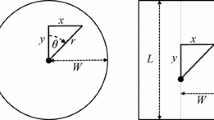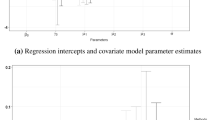Abstract
We present a new method for estimating a distribution of dispersal displacements (a dispersal kernel) from mark-recapture data. One conventional method of calculating the dispersal kernel assumes that the distribution of displacements are Gaussian (e.g. resulting from a diffusion process) and that individuals remain within sampled areas. The first assumption prohibits an analysis of dispersal data that do not exhibit the Gaussian distribution (a common situation); the second assumption leads to underestimation of dispersal distance because individuals that disperse outside of sampling areas are never recaptured. Our method eliminates these two assumptions. In addition, the method can also accommodate mortality during a sampling period. This new method uses integrodifference equations to express the probability of spatial mark-recapture data; associated dispersal, survival, and recapture parameters are then estimated using a maximum likelihood method. We examined the accuracy of the estimators by applying the method to simulated data sets. Our method suggests designs for future mark-recapture experiments.
Similar content being viewed by others
References
KE Anderson (2004) The spatial population dynamic consequences of dispersal behaviour: Case studies in aquatic and terrestrial systems University of California Santa Barbara
C Brownie JE Hines JD Nichols KH Pollock JB Hestbeck (1993) ArticleTitleCapture-recapture studies for multiple strata including non-Markovian transitions Biometrics 49 1173–1187
KP Burnham D Anderson (2002) Model selection and multi-model inference Springer-Verlag New York
E Catchpole B Morgan (1997) ArticleTitleDetecting parameter redundancy Biometrika 84 187–196 Occurrence Handle10.1093/biomet/84.1.187
JS Clark (1998) ArticleTitleWhy trees migrate so fast: confronting theory with dispersal biology and the paleorecord Am Nat 152 IssueID2 204–224 Occurrence Handle10.1086/286162 Occurrence Handle18811386 Occurrence Handle1:STN:280:DC%2BD1cnit1yltw%3D%3D
JS Clark M Lewis L Horvath (2001) ArticleTitleInvasion by extremes: population spread with variation in dispersal and reproduction Am Nat 157 IssueID5 537–554 Occurrence Handle10.1086/319934 Occurrence Handle18707261 Occurrence Handle1:STN:280:DC%2BD1critlyjsw%3D%3D
MR Easterling SP Ellner PM Dixon (2000) ArticleTitleSize-specific sensitivity: applying a new structured population model Ecology 81 IssueID3 694–708 Occurrence Handle10.2307/177370
M Evans N Hastings B Peacock (1993) statistical distributions Wiley Inc. New York
Fujiwara M (2002). Mark-recapture statistics and demographic analysis. Ph.D. Thesis. MIT/WHOI, 2002–08
M Fujiwara H Caswell (2002) ArticleTitleA general approach to temporary emigration in mark-recapture analysis Ecology 83 3266–3275
SD Gerking (1959) ArticleTitleThe restricted movement of fish populations Biol Rev 34 221–242
C Gowan MK Young KD Fausch SC Riley (1994) ArticleTitleRestricted movement in resident stream salmonids: a paradigm lost? Can J Fish Aquat Sci 51 2626–2637 Occurrence Handle10.1139/f94-262
JB Hestbeck JD Nichols RA Malecki (1991) ArticleTitleEstimates of movement and site fidelity using mark-resight data of wintering Canada geese Ecology 72 523–533 Occurrence Handle10.2307/2937193
TM Jenkins SuffixJr S Diehl KW Kratz SD Cooper (1999) ArticleTitleEffects of population density on individual growth of brown trout in streams Ecology 80 941–956 Occurrence Handle10.2307/177029
WL Kendall JD Nichols JE Hines (1997) ArticleTitleEstimating temporary emigration using capture-recapture data with Pollock’s robust design Ecology 78 563–578 Occurrence Handle10.2307/2266030
WL Kendall JD Nichols (1995) ArticleTitleOn the use of secondary capture-recapture samples to estimate temporary emigration and breeding proportions J Appl Stat 22 751–762 Occurrence Handle10.1080/02664769524595
WL Kendall KH Pollock C Brownie (1995) ArticleTitleA likelihood-based approach to capture-recapture estimation of demographic parameters under the robust design Biometrics 51 293–308 Occurrence Handle7766783 Occurrence Handle1:STN:280:DyaK2M3osVansQ%3D%3D
M Kot (1989) ArticleTitleDiffusion-driven period-doubling bifurcations Biosystems 22 279–287 Occurrence Handle2804265 Occurrence Handle1:STN:280:DyaK3c%2FivVGqsw%3D%3D Occurrence Handle10.1016/0303-2647(89)90049-X
M Kot MA Lewis P Driessche ParticleVan den (1996) ArticleTitleDispersal data and the spread of invading organisms Ecology 77 IssueID7 2027–2042 Occurrence Handle10.2307/2265698
M Kot WM Schaffer (1986) ArticleTitleDiscrete-time growth-dispersal models Math Biosci 80 IssueID1 109–136 Occurrence Handle10.1016/0025-5564(86)90069-6
J-D Lebreton KP Burnham J Clobert DR Anderson (1992) ArticleTitleModeling survival and testing biological hypotheses using marked animals: a unified approach with case studies Ecol Monogr 62 IssueID1 67–118 Occurrence Handle10.2307/2937171
Math Works Inc. (1999). MATLAB, Release 11. Natic, MA
PAP Moran (1951) ArticleTitleA mathematical theory of animal trapping Biometrika 38 307–311 Occurrence Handle10.2307/2332576
MG Neubert M Kot MA Lewis (1995) ArticleTitleDispersal and pattern formation in a discrete-time predator-prey model Theor Popul Biol 48 IssueID1 1995 Occurrence Handle10.1006/tpbi.1995.1020
MG Neubert H Caswell (2000) ArticleTitleDemography and dispersal: calculation and sensitivity analysis of invasion speed for structured populations Ecology 81 IssueID6 1613–1628 Occurrence Handle10.2307/177311
MG Neubert M Kot MA Lewis (2000) ArticleTitleInvasion speeds in fluctuating environments Proc R Soc Lond Ser B: Biol Sci 267 IssueID1453 1603–1610 Occurrence Handle1:STN:280:DC%2BD3MvhvFOmsg%3D%3D Occurrence Handle10.1098/rspb.2000.1185
A Okubo (1980) Diffusion and ecological problems: mathematical models Springer-Verlag New York
KH Pollock (1982) ArticleTitleA capture-recapture design robust to unequal probability of capture J Wildl Manage 46 752–757
JA Rice (1995) Mathematical statistics and data analysis EditionNumber2 Duxbury Press Belmont, CA
MA Rodriguez (2002) ArticleTitleRestricted movement in stream fish: the paradigm is incomplete, not lost Ecology 83 1–13
N Shigesada K Kawasaki (1997) Biological invasions: theory and practice Oxford University Press Oxford
GT Skalski JF Gilliam (2000) ArticleTitleModeling diffusive spread in a heterogenous population: a movement study with stream fish Ecology 81 1685–1700 Occurrence Handle10.2307/177317
P Turchin (1998) Quantitative analysis of movement: measuring and modeling population redistribution in animals and plants Sinauer Sunderland, MA
RW Kirk ParticleVan MA Lewis (1996) ArticleTitleDispersal data and the spread of invading organisms Bull Math Biol 59 IssueID1 107–137
Author information
Authors and Affiliations
Corresponding author
Additional information
Received: January 2004 / Revised: July 2005
Rights and permissions
About this article
Cite this article
Fujiwara, M., Anderson, K.E., Neubert, M.G. et al. On the Estimation of Dispersal Kernels from Individual Mark-Recapture Data. Environ Ecol Stat 13, 183–197 (2006). https://doi.org/10.1007/s10651-005-0007-z
Issue Date:
DOI: https://doi.org/10.1007/s10651-005-0007-z




